Difference between AR and Spatial Computing
Augmented reality (AR) and spatial computing are two related concepts, but they address different aspects of computer-assisted augmentation of the real world.
Augmented Reality (AR)
AR refers to the overlaying of virtual content onto the physical environment to provide an augmented view of reality. It involves using a device's camera to capture the environment. Then, computer-generated images, videos or 3D objects are inserted into the camera image in real time. The user can see these virtual elements as if they were actually part of the physical world. AR is very commonly used in mobile applications, such as games, navigation, shopping, or to support repairs or training.
Spatial Computing
involves interactions with digital content in a three-dimensional space. It enables the capture and processing of data about the physical environment in real time to place, manipulate, and interact with virtual objects or information. Spatial computing uses technologies such as sensors, cameras, computer vision, machine learning and artificial intelligence to create an immersive and interactive experience in a spatial context. It can go beyond AR by enabling the display and manipulation of virtual content in an extended spatial domain, for example, through the use of headsets or other devices that provide a full 3D experience.
In other words, AR is a specific application of spatial computing in which virtual content is overlaid on the real world. While Spatial Computing is a broader concept that encompasses spatial perception and interaction with digital content in a 3D space. Regardless of whether or not they are overlaid onto the real world.
One notable device in the field of spatial computing is the HoloLens 2 from Microsoft. It is a mixed reality headset that integrates elements of both AR and VR. The HoloLens 2 allows users to project holographic images into their real space and interact with them as if they were physically present. The device has advanced sensors that can sense the environment in real time and respond to user movements, resulting in intuitive and natural interaction with digital content.





